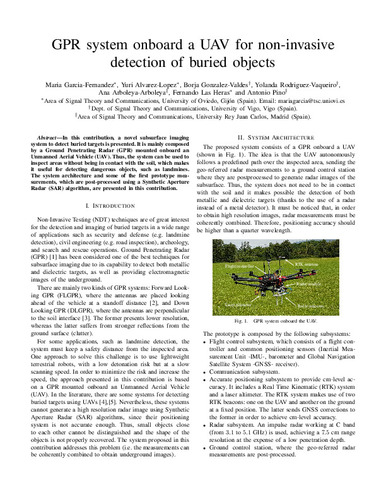GPR system onboard a UAV for non-invasive detection of buried objects.
Palabra(s) clave:
drones
imaging
GPR
minas antipersona
Fecha de publicación:
Editorial:
The IEEE
Descripción física:
Resumen:
In this contribution, a novel subsurface imaging system to detect buried targets is presented. It is mainly composed by a Ground Penetrating Radar (GPR) mounted onboard an Unmanned Aerial Vehicle (UAV). Thus, the system can be used to inspect areas without being in contact with the soil, which makes it useful for detecting dangerous objects, such as landmines. The system architecture and some of the first prototype measurements, which are post-processed using a Synthetic Aperture Radar (SAR) algorithm, are presented in this contribution.
In this contribution, a novel subsurface imaging system to detect buried targets is presented. It is mainly composed by a Ground Penetrating Radar (GPR) mounted onboard an Unmanned Aerial Vehicle (UAV). Thus, the system can be used to inspect areas without being in contact with the soil, which makes it useful for detecting dangerous objects, such as landmines. The system architecture and some of the first prototype measurements, which are post-processed using a Synthetic Aperture Radar (SAR) algorithm, are presented in this contribution.
Descripción:
IEEE International Symposium on Antennas and Propagation and USNC-URSI Radio Science Meeting (2018)
ISBN:
Patrocinado por:
This work has been supported by Government of Spain (under projects TEC2014-55290-lIN, TEC2015-73908-lIN and grant FPUI5/06341), Government of Asturias (IDI/2017/000095) and Galician Government (under project GRC2015/018) and under agreement for funding AtlantTIC.
Colecciones
Ficheros en el ítem




